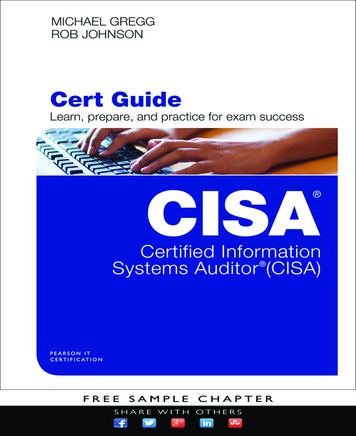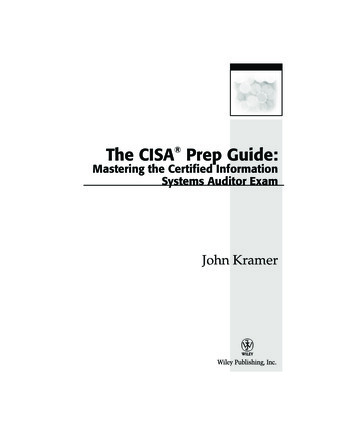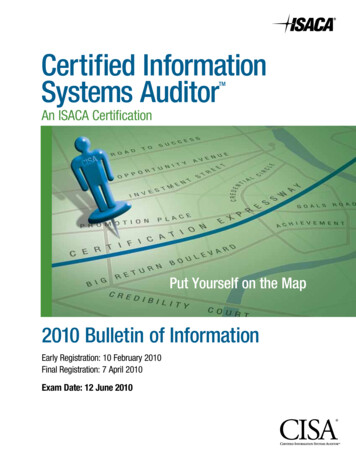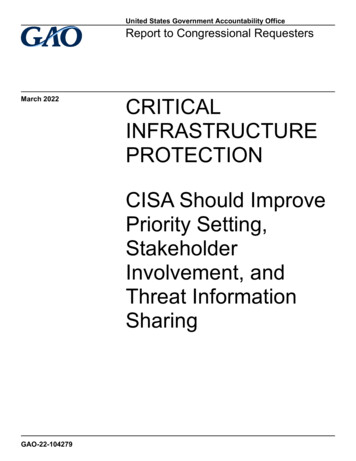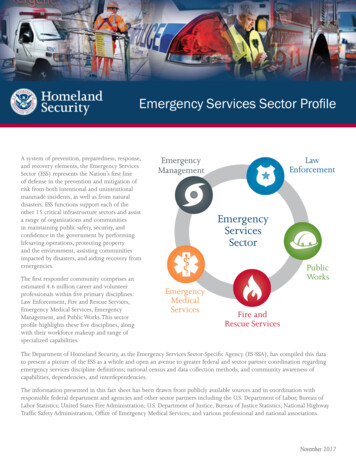
Transcription
Emergency Services Sector ProfileA system of prevention, preparedness, response,and recovery elements, the Emergency ServicesSector (ESS) represents the Nation’s first lineof defense in the prevention and mitigation ofrisk from both intentional and unintentionalmanmade incidents, as well as from naturaldisasters. ESS functions support each of theother 15 critical infrastructure sectors and assista range of organizations and communitiesin maintaining public safety, security, andconfidence in the government by performinglifesaving operations, protecting propertyand the environment, assisting communitiesimpacted by disasters, and aiding recovery fromemergencies.The first responder community comprises anestimated 4.6 million career and volunteerprofessionals within five primary disciplines:Law Enforcement, Fire and Rescue Services,Emergency Medical Services, EmergencyManagement, and Public Works. This sectorprofile highlights these five disciplines, alongwith their workforce makeup and range ofspecialized icesFire andRescue ServicesThe Department of Homeland Security, as the Emergency Services Sector-Specific Agency (ES-SSA), has compiled this datato present a picture of the ESS as a whole and open an avenue to greater federal and sector partner coordination regardingemergency services discipline definitions; national census and data collection methods; and community awareness ofcapabilities, dependencies, and interdependencies.The information presented in this fact sheet has been drawn from publicly available sources and in coordination withresponsible federal department and agencies and other sector partners including the U.S. Department of Labor, Bureau ofLabor Statistics; United States Fire Administration; U.S. Department of Justice, Bureau of Justice Statistics; National HighwayTraffic Safety Administration, Office of Emergency Medical Services; and various professional and national associations.November 2017
Fire and Rescue ServicesThe Federal Fire Prevention and Control Act of 1974 defined ‘‘fire service’’ as any organization in anyState consisting of personnel, apparatus, and equipment which has as its purpose protecting propertyand maintaining the safety and welfare of the public from the dangers of fire. Today, according tothe U.S. Fire Administration (USFA), the term “Fire and Rescue Services” encompasses a variety ofcapabilities and fire service related organizations to include both structural and wildland firefighting,technical rescue services, emergency medical services, as well as State Fire Marshal’s Offices andequivalent agencies, firefighter associations, and other national level entities. The following statistics arederived from the National Fire Department Registry conducted by USFA.27,198fire departments registered with the United States FireAdministration (USFA) (91% of all U.S. fire departments)1,066,300career, volunteer, andpaid per call firefighters50,70021%13%fire stations31%151,00069%35%14%civilian staff andnon-firefighting personnelof all departmentshave one fire stationhave three or morestations% of registered fire departments by regionSpecialized Services Provided by Fire DepartmentsAirport/AviationBasic & AdvancedLife SupportFireboatHazardousMaterials TeamDepartmental (in-house)Training AcademyEMS Non-TransportResponseEMS AmbulanceTransportFire Inspection/Code EnforcementFire Inspection/Cause DeterminationJuvenile FiresetterIntervention ehicle ExtricationWildfire/WildlandUrban Interface71%of registered firedepartments are fullystaffed by volunteers56%of all firefightersare volunteersA firefighter is a rescuer extensively trainedin firefighting and rescue techniques.In addition to possessing firefighting skills, firefightersmay be trained to provide technical rescue services toperform complex rescue operations (e.g. rescue from aconfined space or building collapse, vehicle accident, orswift water). In some areas, firefighters are also crosstrained to provide Emergency Medical Services (EMS)and operate ambulances.States with the highest %of volunteer departmentsStates with the highest %of career nnsylvaniaNorth DakotaSouth DakotaHawaiiFloridaMassachusettsArizonaCaliforniaA fire marshal is a fire official who hasbeen lawfully appointed and charged withstatutory responsibilities and duties for fireprevention. Fire Marshals’ duties vary by jurisdictionand may include fire code enforcement, propertyinspections, investigation of the cause and origin of fires,and dissemination of fire safety education information.November 2017
Law Enforcement“Law enforcement” (LE) is the term that describes the individuals and agencies responsible forenforcing laws and maintaining public order and public safety. LE includes the prevention, detection,and investigation of crimes and the apprehension and detention of individuals suspected of lawviolation. The LE community consists of Federal and State, local, tribal, and territorial (SLTT) LEagencies, courts systems, correctional institutions, and private sector security agencies. The followingstatistics are derived from the U.S. Department of Labor, Bureau of Labor Statistics, and the U.S.Department of Justice, Bureau of Justice Statistics national data collections, to include the Census ofState and Local Law Enforcement Agencies (CSLLEA) Law Enforcement Management and AdministrativeStatistics (LEMAS) survey and Census of Federal Law Enforcement Officers (FLEO).U.S. Law Enforcement CategoriesFederal Law Enforcement AgenciesState, Local, Tribal, and TerritorialLaw Enforcement Agencies73 different agencies, (e.g., U.S. Secret Service,Drug Enforcement Administration, U.S. ParkPolice, Office of Inspectors General, etc.)Local police departments, sheriffs’ offices,primary state LE agencies, special jurisdictionagencies, and other agenciesPrivate-Sector SecurityCompanies and OtherProtective Service ProfessionalsPrivate-sector security guards,transit and rail police, etc.Specialized Capabilities Provided By Law Enforcement AgenciesAviation UnitBomb Squad/Explosive UnitCanine (K-9) UnitCrime SceneInvestigation UnitCrisis Negotiation Unit (CNU) orCrisis Negotiation Team (CNT)Hazardous Materials(HAZMAT) UnitMarine andPort UnitPatrol or Strike TeamPublic SafetyDive TeamRiot/Crowd ControlSearch and Rescue UnitSpecial Weapons andTactics (SWAT) TeamJob FunctionsPoliceresponse/patrolCollection of evidence, interdiction and seizure of contraband, surveillance,execution of search warrants, analysis of information, arrest of suspects,development of cases for prosecutions, or any other investigation andenforcement duties pertaining to federal laws and regulations.Preventive patrol, responding to complaints and reports of illegal activities,arresting law violators, traffic control, crowd control, handling of emergencies, orother traditional law enforcement ionsEmployment and personnel security investigation, civil investigation, inspection,or any other type of noncriminal investigation or enforcement.Corrections/detentionCustody, control, supervision, or transportation of pretrial detainees, prisoninmates, or detained illegal rotectionProviding security for federal buildings, courts, records, assets, or other property,or to providing personal protection for federal government officials, judges,prosecutors, jurors, foreign dignitaries, or any other designated persons.CourtoperationsSupervision of federal offenders on probation, parole, or supervised release. Alsoincludes serving civil or criminal process, and providing witness protection,courtroom security, or other activities related to the federal court system.OtherFunctionsGeneral support, administration, research and development, training, informationsystems, laboratory testing, domestic security intelligence, or any other functionnot included in the other job function categories.Descriptions from U.S. Department of Justice, Bureau of Justice StatisticsNovember 2017
Federal Law Enforcement AgenciesA federal law enforcement agency is an organizational unit, or subunit, of the federal government with the principlefunctions of prevention, detection, and investigation of crime and the apprehension of alleged offenders.Percentage of Federal LE personnel by U.S. Branch of Government 120,00073different agencies24employ4 of 5areemployedby96%of all federal officersfederal agenciesofficersExecutive – 94.5%33 agencies total; thoseagencies that contain thehighest concentration of LEpersonnel include:Dept. of Homeland Security U.S. Customs and BorderProtection U.S. Immigration andCustoms EnforcementDept. of Justice Federal Bureau of Prisons Federal Bureau ofInvestigationfull-time LE officersauthorized to make arrestsand carry firearmsDHSorDOJLegislative – 4%U.S. Capitol PoliceLibrary of Congress Office of Inspector GeneralU.S. Government PublishingOffice Government PublishingOffice Police Office of Inspector GeneralJudicial – 1.5%Administrative office of theU.S. CourtsU.S. Supreme Court PoliceNumbers from U.S. Department of Justice and U.S. Department of LaborState,Local, Tribal, and Territorial Law Enforcement Agencies860,95017,75948%SLTT LE officersof SLTT LEagencies employfewer than 10full-time officers787,470full-time sworn officers44,0005%part-time sworn officers29,480Other Agencies(primarily county constableoffices in Texas)Special JurisdictionAgencies (e.g.,universities, publicschools, transportationfacilities, state criminalinvestigation units)50Primary State Agencies(e.g., state policeagency, highway patrolagency, or departmentof public safey)1,733of SLTT LEagencies employ100 or morefull-time officersunpaid reserve orauxiliary officers638SLTT LE agencies12,3263,012Sheriffs’ OfficesLocal Police Departments(tribal police are classifiedas local police in Bureauof Justice statistics datacollection)Private Sector Security CompaniesCompanies primarily engaged in providing guard and patrol services, such as armed and unarmed security guard services,vehicle patrols, investigative services, risk assessments, and security surveys.1,103,120sandrtentsand scal lsnd lasrtorstig ty Ser nera l Hos emen ar y SEstele moda cal mentg In cilitie sctaevnvegiaedalilnrnpoenI curT comG rgicE conL verS ortsFa r vicmbnkiSeAcSuSeDriGaGoSpSe14,540individuals employedby private sectorsecurity companies8,9008,74023,880 21,49037,570657,130Numbers from U.S. Department of Justice and U.S. Department of Labor31,960 30,960(industries with the highest levels of employment for this occupation)November 2017
Emergency Medical ServicesEmergency Medical Services (EMS) is a system of coordinated response, involving multiple people andagencies that provide prehospital emergency medical care. EMS practitioners may provide both basicand advanced medical care at the scene of an emergency and enroute to a hospital. The organizationalstructure of EMS, as well as who provides and finances the services, varies significantly from communityto community. Prehospital services can be based in a fire department, hospital, independent governmentagency (i.e., public health agency), or nonprofit corporation (e.g., Rescue Squad) or can be provided bycommercial for-profit companies. Regardless of the provider, the essential components of an EMS systemremain the same.2%21,280EMS Agencies81,290EMS Vehicles826,000EMS Professionals28 millionTimes EMS annually transports someone37 millionAnnual EMS calls for serviceAdapted from 2011 National EMS Assessment6%Emergency Medical DispatchOther EMS Agency6%Hospital Based1%TribalTypesof EMSAgencies21%State and LocalGovernment, NotFire Based40%Fire DepartmentBased25%Private,Not Hospital Based% of all EMSprofessionalsEmergency Medical Responder (EMR)The lowest level of responder, the EMR possesses simple skills to provide immediate lifesavingcare for critical patients. The EMR can render on-scene interventions while awaiting additionalresources and may serve on a transport crew, but generally will not be the primary caregiver.6%Emergency Medical Technician (EMT)The EMT conducts basic, noninvasive interventions to reduce the morbidity and mortality ofacute out-of-hospital emergencies. They have all the EMR’s capabilities, plus additional skillsassociated with patient transport. In many places, EMTs provide the majority of out-of-hospitalcare, and in some places, the highest level.64%Advanced EMT (AEMT)The AEMT has all the skills of the EMR and EMT, but can also conduct limited advanced andpharmacological interventions. This level allows provision of high-benefit, lower-risk advancedskills by systems that cannot support paramedic-level care. In some jurisdictions, AEMTs mayrepresent the highest level of out-of-hospital care.6%ParamedicsThe paramedic is an allied health professional who can conduct invasive and pharmacologicalinterventions. Possessing all the skills of the lower-level providers, paramedics can alsoconduct a broader range of interventions based on skills that are harder to maintain and posegreater risk to patients if done incorrectly. Paramedic care is based on advanced assessmentand formulating a field impression.Numbers and descriptions from National Highway Traffic Safety Administration24%November 2017
Public WorksThe United States has approximately 19,400 municipalities of varying sizes. In each community, thereare common needs that must be met through the provision of public works services (e.g., drinkingwater, utilities, trash collection, etc.). Public Works may be defined as the combination of physicalassets, management practices, policies, and personnel necessary for government to provide and sustainstructures and services essential to the welfare and acceptable quality of life for its citizens. Froman emergency management perspective, Public Works is an integral component of a jurisdiction’semergency planning and response efforts.Public Works plays a central role in incident management (both pre- and post-event) by providing much ofthe engineering and technical expertise required to plan, construct, operate, and restore most of a community’s protective andlifeline facilities. During an incident, Public Works may act as the lead agency for debris management, restoration of criticalinfrastructure, and damage assessment.Flood controlRestoration of utility services and communication facilitiesDebris clearance, removal, disposalAssess damage to public structuresUnique Function of Public Works in EmergenciesCommunity Protective and Lifeline FacilitiesCommunicationFacilities(telephone, cabletelevision)Drainage andFlood houses,town halls)(water, sewer,electric, gas)Transportation(streets, highways,bridges, airports,terminals, harbors)Repair damage to roads, bridges, tunnelsEmergency traffic operationsPublic Works Specialized ngineeringand TechnologyFacilitiesFleetServicesGrounds andUrban ForestrySolid WasteManagement2%9%641,870employees in thePublic Works professionTransportationMangementWaterUtility and PublicManagementRight-of-Way1%Emergency Managersand PlannersTraffic Control andTransportation SpecialistsInspectors10%Equipment OperatorsTypes ofPublicWorks jobsand Mechanics12%Facility Workers andGrounds Keepers28%Highway Maintenance andConstruction Workers22%16%Facility and TreatmentPlant OperatorsEngineersNumbers from U.S. Department of LaborNovember 2017
Emergency ManagementEmergency Management is the managerial function charged with creating the framework withinwhich communities reduce vulnerability to hazards and cope with disasters. This managerial functionis typically undertaken by a designated Emergency Manager, who has a working knowledge of all thebasic tenets of emergency management, including mitigation, preparedness, response and recovery, andthe knowledge, skills, and ability to effectively manage a locality’s emergency management program.Emergency Management Specialists and Emergency Management Directors plan for, coordinate, andmanage response efforts.The industries with the highest levels of employment for this occupation include:9,840Emergency ManagementDirectors in the U.S.5,1501,180790350320Local GovernmentState GovernmentGeneral Medical andSurgical HospitalsColleges, Universities,and Professional SchoolsElectric Power Generation,Transmission, andDistributionNumbers from U.S. Department of LaborEmergency Services Sector Specialized CapabilitiesIn addition to foundational capabilities of the disciplines, Federal, SLTT, and private sector assets, networks, and systems alsoprovide specialized emergency services through individual personnel and teams. These specialized capabilities may be found inone or more various disciplines, depending on the jurisdiction.Tactical TeamsTeams of personnel withspecialized training andequipment to handle high-risksituations (e.g., hostage rescue,counterterrorism operations, etc.).While traditionally a LE capability,such as special weapons and tactics(SWAT) teams, cross-training withfire and rescue and EMS personnelhas recently increased.Canine (K-9)/Explosives DetectionCanine (EDC) UnitsUtilized for search and rescue,evidence search and detection(e.g. presence of narcotics,explosives, tobacco products,etc.), and suspect apprehension.2,031full-time SWATpersonnel247883466full-time bombtechscollateralduty asbomb techFBI accreditedBomb Squadsthroughoutthe USduty9,525 collateralSWAT personnelduty2,045 collateralbomb techsEDC752 full-timehandlers163260 full-timedivers114duty360 collateralEDC handlers2,263 collateralduty diversEDC handlerswith collateralduty as bombtechsHazardous Devices/Public Safety BombDisposal TeamsPersonnel specially trainedin the investigation anddisarming of suspectedexplosive devices. (Note:Some bomb squads andbomb techs are assigned tofire departments).Public Safety Dive Teamsdivers withcollateralduty asbomb techTeams of personnel withspecialized training andequipment for underwaterrescue, investigation, andrecovery of evidence. Personnelmay be part of LE, fire andrescue, or EMS organizations.Search and Rescue (SAR) UnitsSpecialized teams of personnel trained in the location, rescue, and initial medical stabilization of distressed individuals. ManyStates and local jurisdictions maintain SAR capabilities. Per the Emergency Support Function #9 Search and Rescue Annex,Federal SAR roles and responsibilities are divided amongst the following primary agencies: Urban SAR (FEMA); Maritime/Coastal/Waterborne SAR (U.S. Coast Guard); and Land SAR (U.S. Department of the Interior and Department of Defense).Search and RescueUnits (SAR)FEMA – Establishes policy and leadsthe coordination of the National UrbanSearch and Rescue Response SystemNumbers from DHS National Counter-Improvised Explosive Device Capabilities Analysis Database; numbers do not include DOD resources28Urban SAR Task Forces spread throughoutthe U.S. trained and equipped by FEMA tohandle structural collapseNovember 2017
Hazardous Materials Response Units (HMRU)Personnel trained and equipped to perform work to control actual or potential leaks, spills, discharges, or releases of hazardousmaterials (HAZMAT). Capability often associated with fire departments, LE organizations, and some federal department andagencies with HAZMAT related responsibilities (e.g. U.S. Environmental Protection Agency, U.S. Coast Guard, FBI, etc.).17.5%HazardousMaterials ResponseUnits (HMRU)of registered fire departmentsprovide this specialized serviceEPA Environmental Response Team (ERT)and Radiological Response Team (RERT)FBI Technical Hazardous Response Unit(THRU)Numbers from USFA National Fire Department RegistryPublic Safety Answering Points (PSAP)A facility that has been designated to receive 9-1-1calls and route them to emergency services personnel.Sometimes known as a Public Safety CommunicationsCenter, a PSAP may act as a dispatch center.5,874primary and secondaryPSAPs in the United States240 millioncalls are made to 911 in theUnited States each yearLaw Enforcement911Someonecalls 911PSAP receives call,collects information,and sends todispatcherDispatchercontactsEMSFire & RescueNumbers from National Emergency Number AssociationNational Guard WMD-Civil Support TeamsFusion CentersSpecialized teams that provide support to civil authoritiesduring a domestic Chemical, Biological, Radiological,Nuclear and high-yield Explosives (CBRNE) incident. CivilSupport Teams (CSTs) provide assistance by identifyingchemical, biological, radiological and nuclear agents andsubstances, assessing current or projected consequences,advising on response measures, and assisting with requestsfor additional support. A CST is typically employed by a state’sAdjutant General under the direction of the state’s governor.A State government-designated facility that providesinformation sharing and analysis for an entire State ormajor urban area. Other names include “InformationAnalysis Center,” “Counter Terrorism Information Center,”and “Regional Intelligence Center.”Sector 1Sector 4Sector 2Sector 5Sector 3Sector 6Information from National Guard Bureau78Fusion Centers in theUnited States57WMD-CSTs in the United States,Territories, and the District of ColumbiaAdapted from National Fusion Center Association “Fusion Centers” 2017November 2017
Fire Marshals' duties vary by jurisdiction and may include fire code enforcement, property inspections, investigation of the cause and origin of fires, and dissemination of fire safety education information. Specialized Services Provided by Fire Departments. November 2017. 13% 31% 21% 35% re departments registered with the United States Fire
